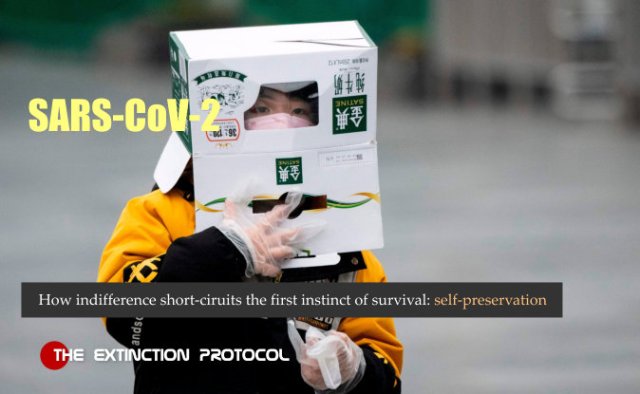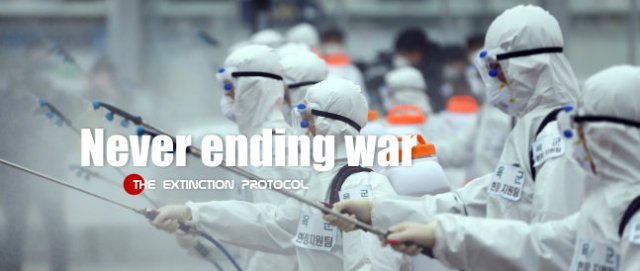SARS-CoV-2: Troubling things about this extremely infectious virus and 7 reasons why you should be worried

A boy wears a cardboard box on his head at the Shanghai Railway station in Shanghai on Feb 13, 2020 (AFP Photo) And while some may laugh – the reality is; he is better protected from the community-transmission of the coronavirus than 95% of most Americans who are being told by health authorities to only wash their hands – risks are low.
Reason 1: As of Feb 29, 2020, there are at least 4 coronavirus cases in the U.S. that are not related to travel. The origins of these infections are unknown. They are the result of community spreading and the carrier or carriers, who transmitted the virus by them or to them could be completely asymptomatic.
News: “There are now at least four US coronavirus cases without any related travel history, health officials say. A woman in Oregon and a high school boy in Washington state are presumptive positives, meaning the tests were conducted at local labs but the results have not yet been confirmed by the CDC. The other two mystery cases are out of California. An older woman in Santa Clara County who had been hospitalized for a respiratory illness tested positive for the virus but had no relevant travel history or contact with anyone infected, health officials said. “This new case indicates that there is evidence of community transmission, but the extent is still not clear,” said Dr. Sara Cody, director of the county’s public health department.
The other California case is a Solano County woman who is hospitalized at UC Davis Medical Center in serious condition. The two counties are about 90 miles apart. The Santa Clara patient had not traveled to Solano County, officials said. With an increase in unknown origin cases and a change in testing guidelines across the country, CDC officials said they were hoping to have every state and local health department testing for the virus by the end of next week. As of early Saturday, there were at least 67 confirmed cases of the coronavirus in the US — the majority of which were repatriated passengers from the Diamond Princess Cruise ship. Worldwide, the virus has killed at least 2,922 — including 2,835 people in China — and there have been 85,055 confirmed cases. Here’s what else you need to know heading into the weekend.” –CNN
Reason 2: Asymptomatic transmission- An asymptomatic carrier (healthy carrier or just carrier) is a person or other organism that has become infected with a pathogen, but that displays no signs or symptoms. SARS-CoV-2 can and has been transmitted by people manifesting no symptoms.
News: “A 20-year-old Chinese woman from Wuhan travelled hundreds of miles to another city where she is believed to have infected five relatives without showing signs of infection, scientists in China have said, offering fresh evidence that the new coronavirus can be spread asymptomatically. The case study, published in the Journal of the American Medical Association, offered clues about how the coronavirus is spreading, and suggested it might be difficult to stop. According to the study, by Dr Meiyun Wang of the People’s Hospital of Zhengzhou University and colleagues, the woman travelled 400 miles (650km) from Wuhan to Anyang in Henan province on 10 January and visited several relatives. When they started getting sick, doctors isolated the woman and tested her for coronavirus. Initially, the young woman tested negative for the virus, but a follow-up test was positive. All five of her relatives developed Covid-19 pneumonia.” –The Guardian, Feb. 22, 2020
Reason 3: Coronaviruses like SARS-CoV-2 may be able to linger on surfaces for over a week. That makes transmission by touching something extremely easy, since the average person touches their face about 23 times an hour, and their mobile phones about every 12 minutes or 80 times a day. (NY Post Nov 8, 2017)
News: “But how long can the new coronavirus linger on surfaces, anyway? The short answer is, we don’t know. But if this new coronavirus resembles other human coronaviruses, such as its “cousins” that cause SARS and MERS, it can stay on surfaces — such as metal, glass or plastic — for as long as nine days, according to a new study. (In comparison, flu viruses can last on surfaces for only about 48 hours.) In the new study, researchers analyzed several dozen previously published papers on human coronaviruses (other than the new coronavirus) to get a better idea of how long they can survive outside of the body. The authors found that these coronaviruses can linger on surfaces for over a week but that some of them don’t remain active for as long at temperatures higher than 86 degrees Fahrenheit (30 degrees Celsius). The authors also found that these coronaviruses can be effectively wiped away by household disinfectants.” –Live Science – Feb 18, 2020

Reason 4: The true mortality rate is a missing variable. Since full disclosure of data from China is lacking, we don’t really know how truly lethal SARS-CoV-2 can be. The mortality rate could range anywhere from 2.3% to up to as high as 11%, like what we see in Iran. A 11% mortality rate would make SARS-CoV-2 as lethal as the 2003 sub-type of SARS but not as lethal as their coronavirus cousin, MERS, whose mortality rate ranged from 34% to 65%.
News: “Iran’s death toll from the coronavirus outbreak has reached 43, a health official told state TV, adding that the number of infected people across the country has reached 593. “Unfortunately, nine people died of the virus in the last 24 hours. The death toll is 43 now. The new confirmed infected cases since yesterday are 205 that make the total number of confirmed infected people 593,” Kianush Jahanpur told state TV today. Iran, which has the highest death toll outside China, has ordered the shutting of schools until Tuesday and the government has extended the closure of universities and a ban on concerts and sports events for a week.
Several high-ranking officials, including a vice minister, deputy health minister and five lawmakers, have tested positive for the coronavirus as the rapid spread of the outbreak forced the government to call on people to stay at home. Iranian media reported that one lawmaker, elected in Iran’s Feb 21 polls, had died of the coronavirus. Iran’s government spokesman will hold his weekly news conference online due to the outbreak, the semi-official Mehr news agency reported.” –NST (Feb. 29, 2020)
Reason 5: SARS-CoV-2 likely has a high R0 factor. In epidemiology, R0 is the basic reproduction number of infections one infected person is thought to generate. COVID-19’s R0 is said to be from 1.4 to 6.6. However, one of the initial patients in Wuhan China infected 14 healthcare workers, and a 61 year-old super-spreader in South Korea infected 37 people.
News: “A so-called super-spreader in South Korea infected at least 37 people at her church with the new coronavirus, and dozens of additional worshipers are also showing symptoms of the disease, called COVID-19, according to news reports… So far, she and 37 other members of the church have tested positive for the novel coronavirus, called SARS-CoV-2, and 52 additional churchgoers have shown symptoms of infection but have not yet been tested.” –Live Science (Feb. 23, 2020)
Reason 6: Americans don’t wear face-masks. Surgical face masks wouldn’t prevent you from inhaling the virus (virus particles are incredibly small) but it would prevent an infected wearer from expelling aerosolized virus droplets into the air. Thus, a key-buffer to slow rates of transmissions in public venues by the masses is noticeably absent from the U.S. anti-viral weapons arsenal. Presently, transmission risks are relatively low but if the US has a major epidemic; community spreading could be devastating. Most surgical face masks are made in China, Vietnam, Taiwan and all these countries have banned both the exports and the raw materials needed to make masks because of epidemics in their own respective countries.
News: “Hospitals and public-health officials in the U.S. and Europe are rationing medical masks and scrounging for more, as they prepare for a potential widening of the coronavirus epidemic. Global hoarding has left European wholesalers with empty shelves. Manufacturers outside China say they won’t be able to fill an exploding stack of orders for months. U.S. hospitals and medical-supply companies have reported dwindling mask inventory and partial or delayed shipments as the surge in global demand for protective equipment enter panic-mode…” –WSJ (Feb. 27, 2020)
Reason 7: A long incubation period and re-infection risks, both characteristics of SARS-CV-2, could be wild-cards aiding in the epidemic transmission of the virus. The explosion of COVID-19 cases in China, on the Diamond Princess cruise ship, in South Korea, Italy, and Iran – all tell us that even with the best safety measures in place, this coronavirus is still capable of explosively spreading.
News: “The list of countries touched by the illness climbed to nearly 61 as Mexico, Belarus, Lithuania, New Zealand, Nigeria, Azerbaijan, Iceland and the Netherlands reported their first cases. More than 83,000 people worldwide have contracted the illness, with deaths topping 2,900.” –AP News

Comments
Post a Comment